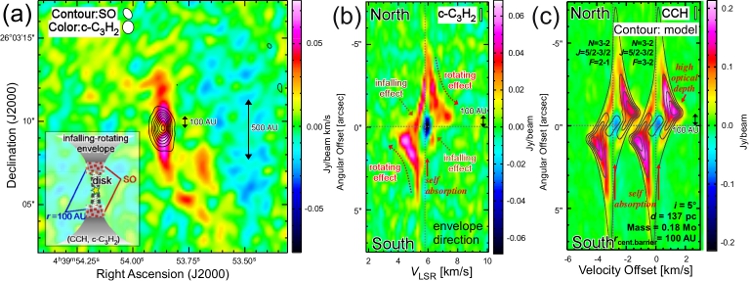| EPoS Contribution |
|
A Drastic Chemical Change in Protostellar Disk Formation
Nami Sakai U Tokyo, Tokyo, JP | |
|
In formation of solar-type stars, a Keplerian disk with a diameter of hundreds of AU is formed around the newly born star from the surrounding infalling envelope. The disk is expected to evolve into a protoplanetary disk and eventually a planetary system. So far, extensive radio astronomical observations have been conducted to unveil the disk formation process, and Keplerian disks are found in some protostars. However, it is still unknown how the disk is formed around the protostar and how interstellar matter is brought into the disk.
Here we report a discovery of a drastic change in the chemical composition of the gas associated with disk formation in the nearby solar-type protostar IRAS 04368+2557 by sub-arcsecond resolution observations with Atacama Large Millimeter/submillimeter Array (ALMA). Specifically, the unsaturated hydrocarbon molecules such as CCH and c-C3H2 resides in the rotating infalling envelope, whereas SO is enhanced in the transition zone at the radius of the centrifugal barrier (100 ± 20 AU), which is defined by analyzing the kinematics of the infalling and rotating envelope. Such a drastic change in chemistry at the centrifugal barrier is caused by the discontinuous infalling motion at the centrifugal barrier and local heating processes there (ex; accretion shock), which will significantly affect chemical evolution from the envelope to the disk. The present result also indicates that the disk formation can be traced by chemistry. Despite extensive studies of protostellar cores aiming at finding the transition from envelope to disk, they have not been successful. This method can be a powerful tool to study the disk formation in various low-mass protostellar sources. | |
 | |
| Caption: (a) Integrated intensity map of c-C3H2 and SO toward L1527. (b-c) Position-velocity diagram of the (b) c-C3H2 and (c) two hyperfine components lines of CCH along a north-south (envelpe direction) line passing through the protostar position. | |
| Collaborators: S. Yamamoto, U Tokyo, Japan |
Suggested Session:
Cores to Disks |

